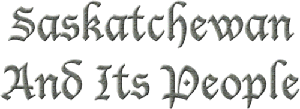THE BARR COLONY. (con't)
this class. It is impossible if you come to think of it that any man in his
senses, could be really grateful for the information that a well was com-
menced at the top. But it is the sort of question that a "josher" might
ask.
A great number of the colonists knew nothing of farming, and some
of these proved the most successful. There was a Mr. J. C. Hill and his
three sons. Mr. Hill was an ex-non-commissioned officer of the British
army, who had been in India. He weighed about 230 pounds and he
walked every step of the way from Saskatoon to Lloydminster. With
him were three grown sons, who had worked in Woolwich arsenal. The
whole four knew nothing of farming. Two of the four would go away
to work while the other two would run the 640 acres comprising their
homesteads. They had nothing to unlearn.
In 1911-10 years later-they took the Colorado Silver Trophy val-
ued at $4,000 awarded by the State of Colorado for the best oats grown
in the United States or Canada. The trophy was competed for again in
1913 at Columbus, Ohio, and again J. C. Hill and Sons were the winners.
The third and final contest was in 1914 at Dallas, Texas. There were
1,300 competitors from the U. S. A. and Canada. Again they were
successful and became the absolute owners of the trophy, which it is
claimed, means that Mr. Hill and his three sons, who in 1901 were ignor-
ant of farming pursuits, thirteen years later held a $4,000 prize and
the world's championship for oats. Up to 1922 Lloydminster farmers
had taken sixty-five international and provincial prizes for grain and
stock. Mr. Barr was severely and deservedly criticised, but there is no
doubt he laid Saskatchewan and Alberta under an obligation for all
time, when he engineered his big Colony scheme. The main plank of
the colony platform was its all British feature. The idea was to form
a community where the people would be all of one nationality and faith
and who would presumably be able to live in sympathetic harmony one
with the other. These schemes do not receive any special blessing. Be-
fore long the Rev. G. E. Lloyd found himself facing Magistrates Black-
burn and Amos on a charge of libel, for writing a certain letter. The
case was dismissed. The official name was the Brittania Colony, but it
was often referred to as the All-British Colony. There was an abun-
dance of first class musical talent in the colony and as winter approached
a meeting was held in what was known as the "Immigration Tent," at
which a society was formed with the object of conducting weekly con-
certs through the winter. Next season a rifle association was formed
with a membership of 150 and Major Poulter as its leading spirit.
Rev. I. M. Barr was a clergyman in London when he conceived his
idea. He came out with the colonists, but he had made a previous visit
to Battleford. He started out to view the lands he had selected on the
map, but he never saw them. His guide told me they got about half
way when Mr. Barr turned back. He seemed to indicate a connection
between the almost total disappearance of a certain class of refresh-
Bibliography follows:

